On 12 November 1912, a search party on the Ross Ice Shelf in Antarctica found the frozen bodies of Captain Robert F. Scott and two companions, eight months after the men perished on a return trip from planting England’s flag at the South Pole. An expedition that had started two years earlier with such great expectations (they hoped to be the first to reach the South Pole) ended in abject misery as the three men spent the last nine days of their lives in Scott’s tent buried by a raging blizzard as food and fuel ran out – the swirling snow and bitterly cold temperatures preventing them from reaching their next supply depot just 11 miles away.
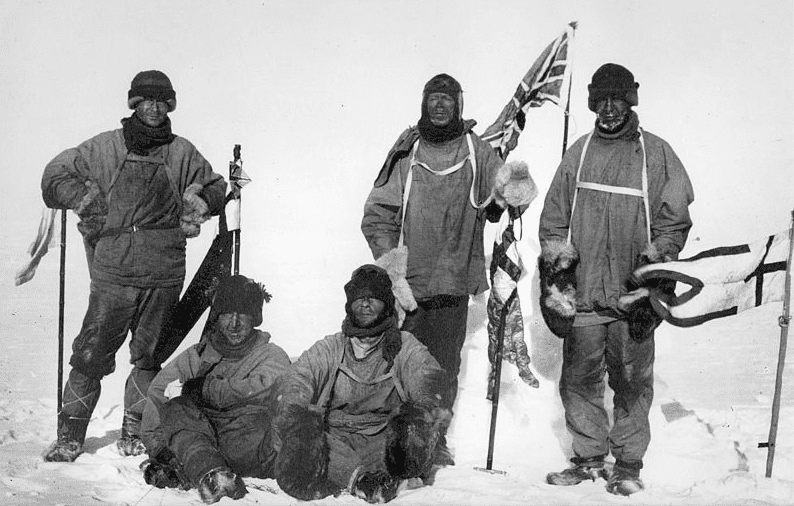
Their deaths were the last in a string of losses and disappointments that plagued the expedition, starting when Scott and four men finally reached the South Pole on January 17. The next day, they discovered that Norwegian explorer Roald Amundsen had beaten them to the honor by 34 days. Amundsen had left a tent and Norwegian flag to commemorate his arrival at the Pole on 14 December 1911, along with a note to Scott.
Upon discovering that Amundsen had beaten him, Scott wrote in his diary “The worst has happened” and commented “Great God! This is an awful place.”
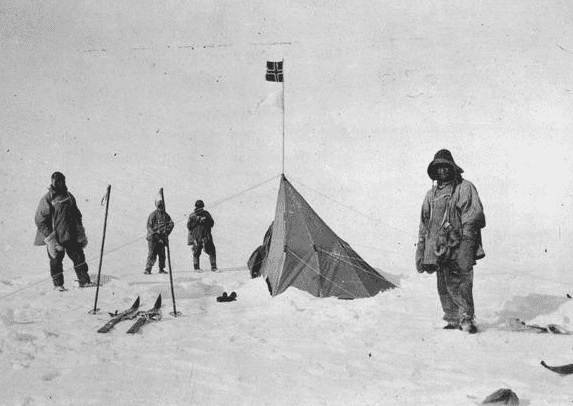
Things worsened as the five disheartened explorers struggled to retrace the 800 miles back to their home base. One of the men, Edgar Evans, died on February 17 after he weakened and fell repeatedly on the ice. The other four men had 400 miles remaining to get across the Ross Ice Shelf, and they were fighting extreme weather, exhaustion, dwindling food and fuel, snow-blindness and severe frostbite. They had no dogs, and were pushing their supply sledges themselves. Their situation was bleak, and continued to deteriorate.
On March 17 Lawrence Oates, barely able to move due to worsening frostbite, decided he had become too much of a burden to his companions. He stepped outside of the tent after telling the other three “I may be some time” and walked off to die on his own.
Scott, Henry Bowers and Edward Wilson pushed on for another 20 miles when the harsh blizzard struck on March 20, confining the men to Scott’s tent for the last nine days of their lives. They knew the next supply depot was only 11 miles away, but they could not reach it. In the dim light, with frozen fingers, Scott scribbled a “message to the public” in which he said:
“Had we lived, I should have had a tale to tell of the hardihood, endurance, and courage of my companions which would have stirred the heart of every Englishman. These rough notes and our dead bodies must tell the tale…”
His final diary entry, 29 March 1912, stated:
“I do not think we can hope for any better things now. We shall stick it out to the end, but we are getting weaker, of course, and the end cannot be far.”
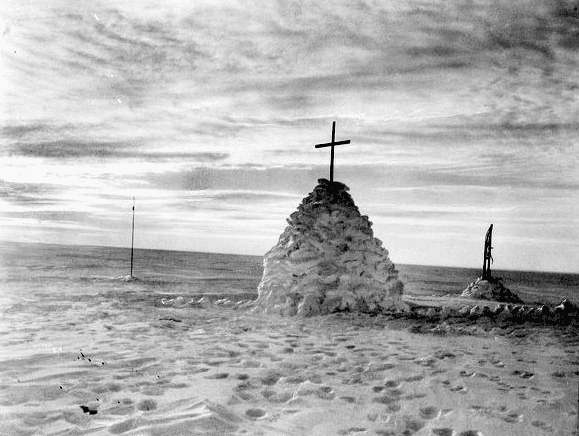
It took time for news of the discovery of the explorers’ frozen bodies to reach the outside world. The Evening News published two poignant articles about the explorers’ fate. The first was an account of their death. The next day, the paper ran an article in which Amundsen movingly speaks of his fellow polar adventurers.
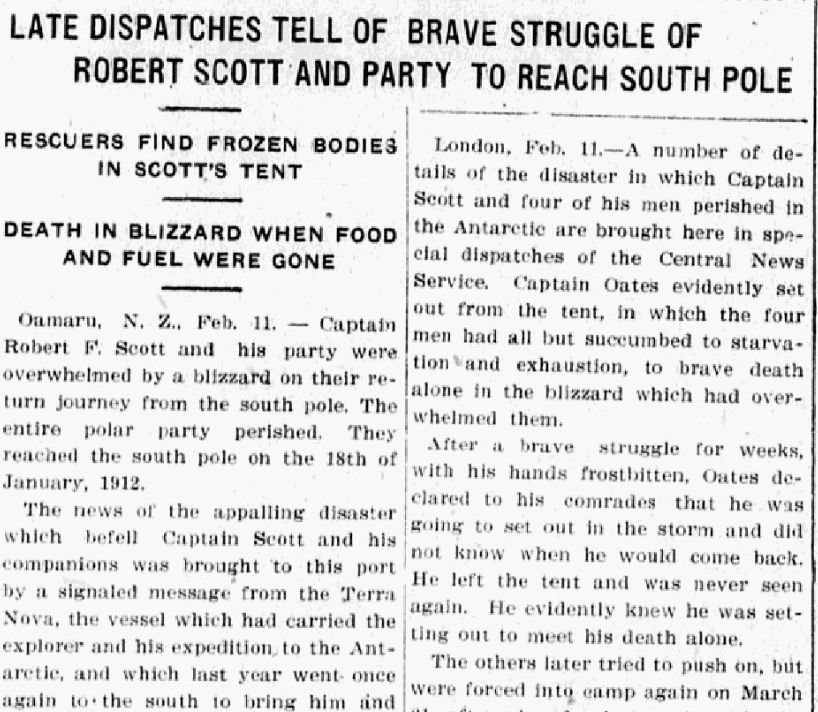
Here is a transcription of this article:
LATE DISPATCHES TELL OF BRAVE STRUGGLE OF ROBERT SCOTT AND PARTY TO REACH SOUTH POLE
RESCUERS FIND FROZEN BODIES IN SCOTT’S TENT
DEATH IN BLIZZARD WHEN FOOD AND FUEL WERE GONE
Oamaru, N. Z., Feb. 11. – Captain Robert F. Scott and his party were overwhelmed by a blizzard on their return journey from the south pole. The entire polar party perished. They reached the south pole on the 18th of January, 1912.
The news of the appalling disaster which befell Captain Scott and his companions was brought to this port by a signaled message from the Terra Nova, the vessel which had carried the explorer and his expedition to the Antarctic, and which last year went once again to the south to bring him and his companions back.
Captain Scott’s party reached the exact point where Roald Amundsen planted the Norwegian flag at the south pole. They found there the hut constructed and left behind by Amundsen’s party.
These facts were recorded in the documents found on the bodies of the explorers when they were recovered.
Those who perished besides Captain Robert F. Scott were Dr. A. E. Wilson, Lieutenant H. R. Bowers, Captain L. E. G. Oates and Petty Officer E. Evans. When the explorers failed to return a rescue party was sent out from Cape Evans late in October. This party reached One Ton Depot and found the provisions in good order. The party proceeded along the southern route and came upon Scott’s tent on November 12. Within lay the bodies of Scott, Wilson and Bowers. Oates died a few days later [actually, about 12 days earlier – ed.].
Captain Scott’s main traveling party was to consist of 16 men besides himself, while groups of four men each were to return at different stages of the journey, leaving Scott and four others to complete the final dash to the Pole.
London, Feb. 11. – A number of details of the disaster in which Captain Scott and four of his men perished in the Antarctic are brought here in special dispatches of the Central News Service. Captain Oates evidently set out from the tent, in which the four men had all but succumbed to starvation and exhaustion, to brave death alone in the blizzard which had overwhelmed them.
After a brave struggle for weeks, with his hands frostbitten, Oates declared to his comrades that he was going to set out in the storm and did not know when he would come back. He left the tent and was never seen again. He evidently knew he was setting out to meet his death alone.
The others later tried to push on, but were forced into camp again on March 21, after nine days’ struggle with the blizzard. Food and fuel were both exhausted.
Probably realizing that his party was doomed, Captain Scott entered in his diary four days later, on March 25, “a message to the public.” In this he declared that disaster was not due to faulty organization, but to misfortune. He said nobody in the world could expect to successfully encounter such temperatures and storms as they had met on the barrier, which so retarded their progress.
When they arrived within 11 miles of One Ton Depot they had food for one hot meal and fuel for two days.
The doomed explorer wrote apologetically of his “rough notes.” He said these and the bodies must tell the tale. He appealed to his countrymen for the care of those dependent upon the perishing explorers.
According to the special dispatches, the Terra Nova relief party which found the bodies read a simple burial ritual over them.
The relief expedition then set out in search for the body of Captain Oates, but although they covered over 70 miles they found no trace of his body.
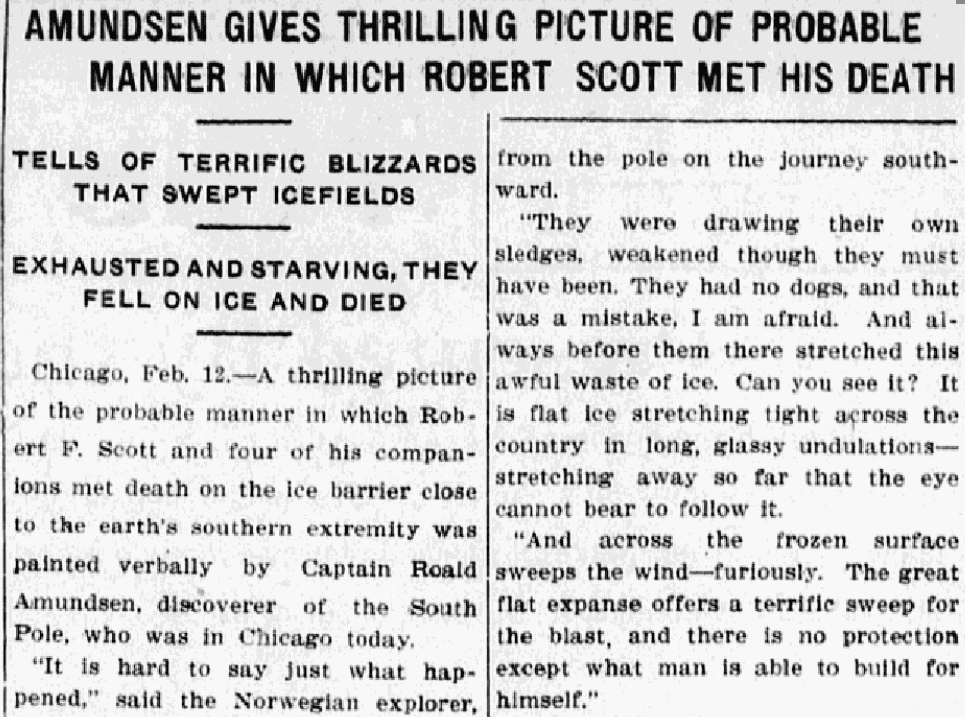
Here is a transcription of this article:
AMUNDSEN GIVES THRILLING PICTURE OF PROBABLE MANNER IN WHICH ROBERT SCOTT MET HIS DEATH
TELLS OF TERRIFIC BLIZZARDS THAT SWEPT ICEFIELDS
EXHAUSTED AND STARVING, THEY FELL ON ICE AND DIED
Chicago, Feb. 12. – A thrilling picture of the probable manner in which Robert F. Scott and four of his companions met death on the ice barrier close to the earth’s southern extremity was painted verbally by Captain Roald Amundsen, discoverer of the South Pole, who was in Chicago today.
“It is hard to say just what happened,” said the Norwegian explorer, “but we can imagine, perhaps, although it is horrible. We know, of course, that it happened about the 79th parallel and that they were down on the barrier and plateau. And just about there our positive knowledge stops.
“Certainly they were exhausted and starving. They were not in a fit condition to meet the terrible blizzard when it came.
“Not that blizzards are unusual. Scott was prepared for blizzards, for he was no amateur. One may always expect blizzards in that country. But there they were – those poor forlorn fellows – straggling along without even ponies to draw their sledges, for they had sent back their last ponies when they had reached a point 150 miles from the pole on the journey southward.
“They were drawing their own sledges, weakened though they must have been. They had no dogs, and that was a mistake, I am afraid. And always before them there stretched this awful waste of ice. Can you see it? It is flat ice stretching right across the country in long, glassy undulations – stretching away so far that the eye cannot bear to follow it.
“And across the frozen surface sweeps the wind – furiously. The great flat expanse offers a terrific sweep for the blast, and there is no protection except what man is able to build for himself.”
Captain Amundsen passed a hand across his eyes.
“And there they died,” he said softly. “Of course, Evans – petty officer – had died already. He fell on the ice. But the others must have died within a short time of each other. Oates went bravely, you know, out into the blizzard that his sickly condition might not hinder the others. That was a great sacrifice, but it did no good.
“I cannot read that last message of Captain Scott’s without emotion. I never met him, personally, but I know he was a brave man.
“And to think,” added the captain in a hushed tone, “that while those brave men were dying in the waste of ice I was lecturing in warmth and comfort in Australia.”
Note: An online collection of newspapers, such as GenealogyBank’s Historical Newspaper Archives, is not only a great way to learn about the lives of your ancestors – the old newspaper articles also help you understand American history and the times your ancestors lived in, and the news they talked about and read in their local papers.
Explore over 330 years of newspapers and historical records in GenealogyBank. Discover your family story! Start a 7-Day Free Trial
